Somewhere in the Pyrenees of Navarra a church bell rang. But for whom?
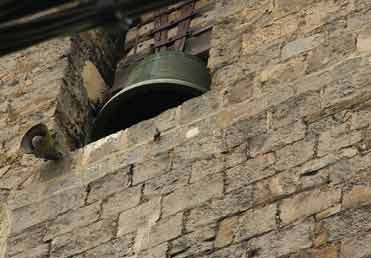
For the intrepid Wallcreeper clinging to its stone and mortar?
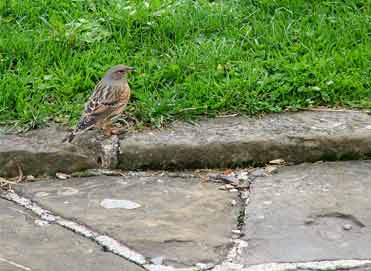
Or for the discreet but confiding Alpine Acccentor on the cobblestones below?
Or for the Hawfinches or Marsh Tits down by the river?
Or for the poor soul who really should buy a decent camera?
Posted in Birds in Spain | No Comments »
The little island of Cabrera lies just off the southeast coast of Mallorca. The island gets its name from “cabra” which means goat in Spanish. “Está como una cabra” is a Spanish expression meaning someone is crazy/crackers (literally “like a goat”).
Well, I’ve just gone a little crazy after reading what the ringers (especially Eduardo Amengual) have caught there this autumn:
3 Olive-backed Pipits (2 ringed, 1 observed)
1 Eastern Common Redstart (Phoenicurus phoenicurus samamisicus – for those, like myself, who were not in the know)
1 male Moussier’s Redstart (3rd for Spain)
1 Lesser Whitethroat
1 Yellow-browed Warbler
Birding has that: it’s much more fun actually getting out and seeing the birds than sitting at home and writing about them.
I wonder when I’ll be able to get to the coast…
Posted in Birds in Spain | No Comments »
Looking for Pin-tailed Sandgrouse at Alfés, the only remaining breeding site for the species in Catalonia, has almost become a full-time job in the last couple of years.
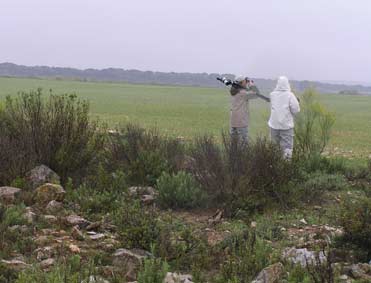
Not too long ago you went to Alfés drylands and you saw Pin-tailed Sandgrouse, it was as easy as that. In fact my birding notebooks from a few years back and beyond reflect that fact, as sometimes I didn’t even write down “Pin-tailed Sandgrouse”, taking it for granted that that was one species that the birder never missed, certainly not the birder who knew his way round.
Now it seems that the Pin-tailed Sandgrouse is a forerunner for the next bird to go extinct in Catalonia.
After the demise of the Dupont’s Lark just a few years ago.
Although it could be pipped at the post by either the Lesser Grey Shrike (will the species return next year?), or the Black-bellied Sandgrouse (the latter has been hanging on for years now despite the odds stacked against it).
And they want to promote birding tourism to the area.
“Can’t have birders without the key birds” I keep telling them. They look at me as if I was speaking Japanese.
Posted in Birds in Spain | No Comments »
This is a typical autumn scene from the drylands of Lleida:
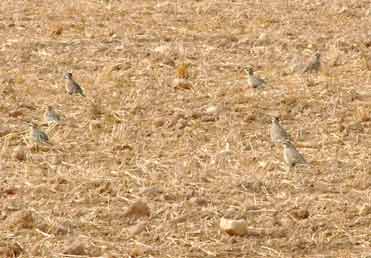
No, not partridges or larks, they are Dotterel Charadrius morinellus.
This year the lucky participants on the famtrip organized by the Catalan Tourist Board were treated to the sight of a flock of 18 Dotterels on the drylands of Alfés, Lleida, Spain. We were watching Thekla Larks when the Dotterel literally flew over our heads and landed in the field in front of us. I had already told the famtrip participants that we were in a good area for migrating Dotterel, but also that due to the nature and brevity of our visit we were not going to look for them.
So it was very nice of the Dotterel to come looking for us!
The Alfés Dotterels already featured in my first book. Part of the text in “Where the birds are in northeast Spain” concerning the Dotterel reads as follows: “flocks that vary in size, but rarely in excess of 50 birds seek out and congregate in ploughed or stubble dryland cereal fields, alternating with smaller patches of fallow land.”
Their presence in the drylands around Lleida is common knowledge now, but not so back in September 1994. Then I almost fell off my motorbike when they crossed the track in front of me on the edge of the thymefields of Alfés.
In the following years I compiled a modest list of personal observations of Dotterels at Alfés:
17 birds on 07/09/94
13 birds on 09/09/95
11 birds on 05/09/96
9 birds on 10/09/97
6 birds on 01/09/99
2 birds on 09/10/99
20 birds on 29/08/00
4 birds on 30/08/01
There’s more, but really all that you need to know to see Dotterels in northeast Spain can be read in “Where the birds are in Northeast Spain”. Detailed information about birding the drylands of Alfés can be found in the drylands of Lleida itinerary on the BirdingInSpain.com website.
Where to stay to be close to the Dotterels, Pin-tailed Sandgrouse, Black Wheatears, etc. of Alfés? La Garbinada.
Posted in Birds in Spain | No Comments »
Little Bustard Tetrax tetrax
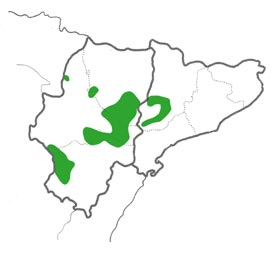 The Little Bustard is a localised resident bird in northeast Spain, breeding mostly in the Ebro valley drylands in Catalonia and Aragón. After breeding the Little Bustard gradually deserts dryland areas and disperses around the surrounding areas, with major concentrations preferring alfalfa fields. Large winter flocks sometimes in excess of 1,000 birds have been found in some years, particularly in the area between Balaguer and Tàrrega.
The Little Bustard is a localised resident bird in northeast Spain, breeding mostly in the Ebro valley drylands in Catalonia and Aragón. After breeding the Little Bustard gradually deserts dryland areas and disperses around the surrounding areas, with major concentrations preferring alfalfa fields. Large winter flocks sometimes in excess of 1,000 birds have been found in some years, particularly in the area between Balaguer and Tàrrega.
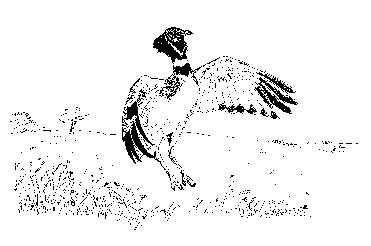 BirdingInSpain.com birding itineraries where Little Bustards can be found in the breeding season: Drylands of Lleida, Monegros Alcolea and Candasnos, Monegros Bujaraloz.
BirdingInSpain.com birding itineraries where Little Bustards can be found in the breeding season: Drylands of Lleida, Monegros Alcolea and Candasnos, Monegros Bujaraloz.
Posted in Birds in Spain | 1 Comment »
A Whitethroat in an almond tree, a Willow Warbler calling from deep in the thicket, a Booted Eagle spiralling over the town of Balaguer. In the last few days the signs have been there for those who can read them: these migratory birds are flying south because they can feel the ripples of autumn, and the sight of them in my part of southern Europe conveys the message to me and people like myself.
I have been hearing Bee-eaters calls from my flat since early July, but now their calls seem irregular and impatient. Last evening a party of 12 Honey Buzzards flew low over our terrace with their characteristic, almost laboured, flapping flight. My wife and I interrupted our game of ping pong to watch them pass.
Dotterel have appeared on their passage through the drylands of Lleida. I’m sure they do so every year, although some years no local birder gets out and looks for them.
I’m now approaching my 20th autumn in this Mediterranean land. Time enough for me to have studied the local bird migration and to know what to expect. I could say the same about the spring migration. I tell myself that these birds will return next spring, although the uncertainties of our world make me hope more than expect.
Posted in Birds in Spain | No Comments »
Pin-tailed Sandgrouse Pterocles alchata
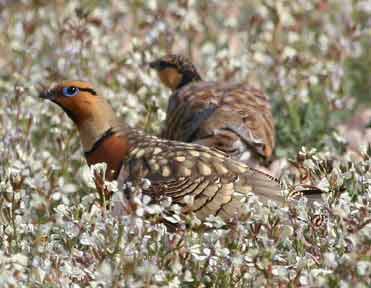
Photo courtesy of Dr. Chris Gibbins
The Pin-tailed Sandgrouse is present all year round in steppe country in the Ebro valley, often forming large flocks in the winter months. Sadly though, it is declining in the region in both range and abundance, due mostly to habitat loss to intensive, irrigated farming. Pin-tailed Sandgrouse inhabit a single site in Catalunya, but are more widespread in Aragón.
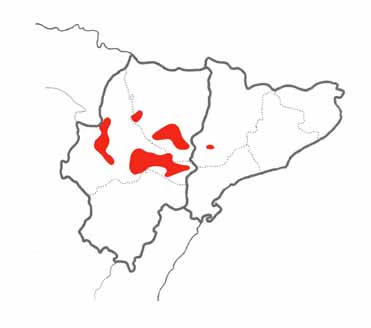
Birding itineraries where the Pin-tailed Sandgrouse can be found: Drylands of Lleida, Monegros: Alcolea and Candasnos, Monegros: Bujaraloz, Belchite steppes.
Posted in Birds in Spain | 3 Comments »
Dear Steve
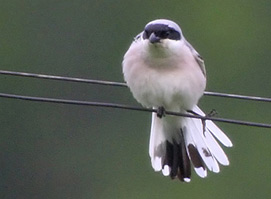
Photo by Eva Solanes
I have just finished reading your book (Flying over the Pyrenees
Standing on the Plains) and must let you know how much I enjoyed it. I
found it to be informative, interesting and very amusing in parts. I
must say I can empathize with you about the nappy incident as I had a
similar experience whilst on holiday on the beach in Puerto Pollensa
when our daughter got a touch (well a lot really) of Franco’s
revenge and I had to bury the remains of her clothing on the beach, we
have never been back there and I have always felt hugely embarrassed and
ashamed as I know the Med is not tidal like the North Sea!
You have found yourself a really lovely part of the world to migrate to,
my husband and I enjoyed our day out with you immensely on our last visit to Spain and wish you every success with your book and look forward to reading the next one.
Regards
Kathleen
SCARBOROUGH UK
What nappy incident is Kathleen refering to? And how can nappies be related to Lesser Grey Shrikes? The answers are in “Flying over the Pyrenees, standing on the plains” .
Posted in Birds in Spain | No Comments »
Audouin’s Gull Larus audouinni
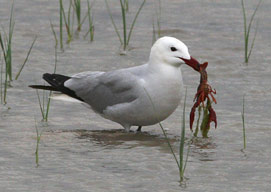
Photo courtesy of Peter Dunn
The Audouin’s Gull is present in Catalonia (Catalunya), northeast Spain, all year round. The world’s most important breeding colony is in the Ebro delta and consists of more than 10,000 pairs. Much smaller numbers remain in the region in the winter. The Audouin’s Gull is frequent in small numbers elsewhere along the coast in Tarragona, becoming irregular or scarce further north to Cap de Creus on the coast of Girona.
Birding itineraries from the BirdingInSpain.com web site where the Audouin’s Gull can be seen: Ebro delta north and south, Llobregat delta.
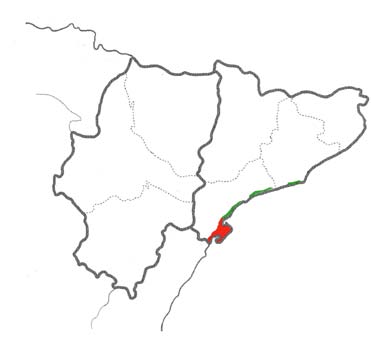
Posted in Birds in Spain | No Comments »
Little Bittern, Squacco Heron, Night Heron, Purple Heron, Grey Heron, Cattle Egret – could all be nesting in a wetland near Lleida that used to be a rubbish tip. It was going cheap so Lleida City Council bought it, but they don’t really know what to do with it. While they’re sitting thinking about it at least the birds have shown enough initiative to use it as a nesting site.
So for the time being it’s just the odd poacher, the shepherd, the bird counter (me) and the birds. Until some rich, progressive-minded benefactor comes up with the cash to give it a facelift. As long as the birds keep coming, I don’t mind it too much as it is. I can listen to the Golden Orioles, the Melodious Warblers, and may even get a glimpse of the Kingfisher. There aren’t many places with more birds than people so close to Lleida city.
Posted in Birds in Spain | No Comments »





 The Little Bustard is a localised resident bird in northeast Spain, breeding mostly in the Ebro valley drylands in Catalonia and Aragón. After breeding the Little Bustard gradually deserts dryland areas and disperses around the surrounding areas, with major concentrations preferring alfalfa fields. Large winter flocks sometimes in excess of 1,000 birds have been found in some years, particularly in the area between Balaguer and Tàrrega.
The Little Bustard is a localised resident bird in northeast Spain, breeding mostly in the Ebro valley drylands in Catalonia and Aragón. After breeding the Little Bustard gradually deserts dryland areas and disperses around the surrounding areas, with major concentrations preferring alfalfa fields. Large winter flocks sometimes in excess of 1,000 birds have been found in some years, particularly in the area between Balaguer and Tàrrega. BirdingInSpain.com birding itineraries where Little Bustards can be found in the breeding season: Drylands of Lleida, Monegros Alcolea and Candasnos, Monegros Bujaraloz.
BirdingInSpain.com birding itineraries where Little Bustards can be found in the breeding season: Drylands of Lleida, Monegros Alcolea and Candasnos, Monegros Bujaraloz.



